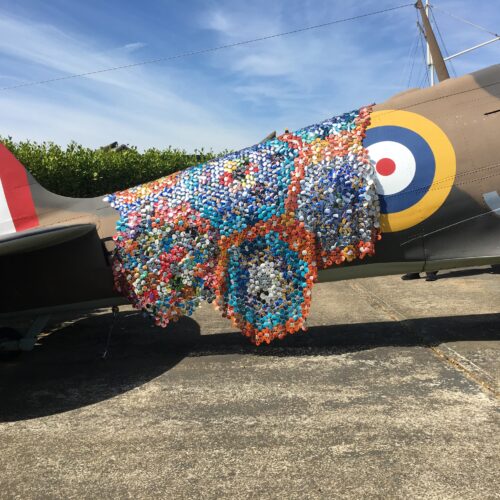
Looking at the future of textiles: Science and technology
Many Artists and designers use more unconventional techniques and unusual methods, usually from other fields to create their collections. Sometimes using materials or processes that are technology/science led bring very interesting outcomes and new ways of working that can open new doors for the future of Arts and Design.
Tight-fitting T-shirts and hipster jeans would get even snugger if you could just spray them on.
A liquid mixture developed by Imperial College London and a company called Fabrican lets you spray clothes directly onto your body, using aerosol technology.
After the spray dries, it creates a thin layer of fabric that can be peeled off, washed and re-worn. “The original idea was to make a futuristic, seamless, quick and comfortable material,” says Manuel Torres, a Spanish fashion designer and academic visitor at Imperial College. Torres worked with Paul Luckham, a professor of particle technology at the College to create the material. The spray-on fabric consists of short fibres that are combined with polymers to bind them together and a solvent that delivers the fabric in liquid form. The solvent evaporates when the spray touches the surface. The fabric is formed by cross-linking fibres, which cling to one another to create the garment. The spray-on fabric is pretty versatile. It can be created in many colours and and use different types of fibres ranging from natural to the synthetic.
In 2008, Sheila Kennedy, a faculty member of MIT’s School of Design, developed new solar textiles and used them to create the first sustainable, energy yielding curtains. The curtains were developed for a green-living exhibit at the Vitra Design Museum in Germany, and the best thing about them is that they can produce up to 16,000 watt-hours of electricity, or about half of what’s needed to power up a house every day.
Like regular solar cell panels, the curtains absorb sunlight in the daytime and hold it in as needed. As currently designed, the ‘soft panel’ curtains can cover walls or roofs, but they might be applicable in other forms.

The fabric of the future won’t be just plain chiffon, silk or cotton. Instead electroluminescent material, microprocessors and LEDs may be woven together with clothing fibers to create smart textiles. Clothing can be considered a second skin and by implementing technology in it, you are bringing it into your intimate space.
Nicky Assmann, created a dress with 35 old circuit boards stitched together, the designer built the dress over a four month period and she chose circuit boards as the fabric for her dress because she liked their look. They have many details and are very systematic, like a grid or a city map.

The circuit dress is not just clothing but also a musical instrument. The dress is based on the idea of circuit bending, which involves deliberately short-circuiting electronic musical devices to get unexpected noise. Twelve coils are incorporated into the dress, each of which is played by connecting it to one another through copper finger plates. The musical composition results as the fingers explore the dress. There are two speakers on the front of the dress, and the entire dress runs on batteries. The straps on the dress are made from electric cables that are are used for rewiring the circuit-bended board from the back to the coils to the front.
Although overall, the dress weighs about 20 pounds, you couldn’t wear it for too long or the straps would hurt your shoulder.
For a modern take on a traditional rug, Dorith Sjardijn embedded electroluminescent material into a hand-tufted wool carpet. It is called 8 Bitskleed feels familiar, She tufted fibres of the electroluminescent material into an existing carpet and backed the entire rug with rubber for durability.

Another interesting project comes from software engineer and web developer Melissa Coleman, she feels fabric should store memories. So she created a trench coat that reads fabric punch cards from one of its electronically enhanced pockets and tells stories of an old man’s life.
The trench coat, that she has called “Charlie,” was inspired by an article written by Bruce Sterling in which he pointed out that new media becomes obsolete faster than old media.
In a way, Charlie the coat attempts to change that as it preserves stories in the form of punch cards in its pockets. Melding technology with the textile makes the entire piece more personal and lasting.
To read the holes in the punch card, the coat uses LEDs and light sensors. An extra LED-light sensor pair helps detect the presence of a card. You can listen to it through the headphones that are integrated in the coat. Most of the electronics in the coat are custom made.







This is amazing. Thanks
Reading the modern take on the traditional rug, I find this quite fascinating and can see it as a very stimulating product for children and adults with special needs, or even in a childrens hospital.